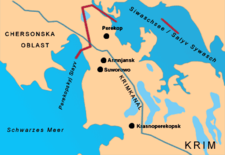Isthmus of Perekop: Difference between revisions
m copyedit, already indirectly in category, refine cat, and AWB general fixes using AWB |
refine category structure |
||
| Line 29: | Line 29: | ||
[[Category:Landforms of Crimea]] |
[[Category:Landforms of Crimea]] |
||
[[Category:Landforms of Ukraine]] |
[[Category:Landforms of Ukraine]] |
||
[[Category: |
[[Category:Isthmusas of Russia|Perekop]] |
||
Revision as of 20:25, 27 February 2015

The Isthmus of Perekop (Ukrainian: Перекопський перешийок; translit. Perekops'kyy pereshyyok; Russian: Перекопский перешеек; translit. Perekopskiy peresheek Crimean Tatar: Or boynu, Turkish: Orkapı) is the narrow, 5–7 kilometres (3.1–4.3 mi) wide strip of land that connects the Crimean Peninsula to the mainland of Ukraine. The isthmus is located between the Black Sea to the west and the Sivash to the east. The isthmus takes its name from the Tatar fortress of Perekop.
The border between the Crimea republic and the Kherson Oblast runs though the northern part of the isthmus. The cities of Perekop, Armyansk, Suvorovo and Krasnoperekopsk are situated on the isthmus. The North Crimean Canal runs through the isthmus, supplying Crimea with fresh water from the Dnieper River.
South of Perekop, there are rich salt ores which still are very important commercially for the region.
Name
The name Or Qapı in Crimean Tatar language means Or - trench and Qapı - gate, the Greek name Tafros means a dug-out trench, and Perekop in Slavic languages literally means a dug-out.
History
The strategic and commercial value of this area, together with the strategic value of being the gateway to Crimea, has made the isthmus the location of some particularly fierce battles. Both ancient Greeks and Crimean Tatars fortified the area, and in the 15th century the area was a colony of the maritime Republic of Genoa. In 1783 the area became a part of Russia, and in 1954, together with Crimea it was transferred to the Ukrainian Soviet Republic.
In November 1920, during the Russian Civil War, a battle was fought here between Red Army and the White troops of Baron Wrangel, who was still controlling the Crimea. The Red Army turned out victorious, but 140,000 civilians fled over the Black Sea to Istanbul. This historical event was made into a 1968 film Two Comrades Were Serving.
During Second World War, the combined forces of German and Romanian troops under the command of Erich von Manstein entered Crimea through the Isthmus of Perekop. The battle of the isthmus lasted five days from September 24, 1941 before the isthmus was secured by the Axis forces. On October 27 the Axis forces advanced further into Crimea, leading to the Battle of Sevastopol. On 9 May 1944, the Red Army regained control of Crimea.
On March 2, 2014, it was reported that Russian troops were digging trenches along the border between Crimea and the rest of Ukraine, which runs across the isthmus.[1]
Russia annexed Crimea from Ukraine on March 18, 2014.
References
- ^ "Ukraine orders full military mobilisation over Russia moves". BBC News. Retrieved March 2, 2014.

